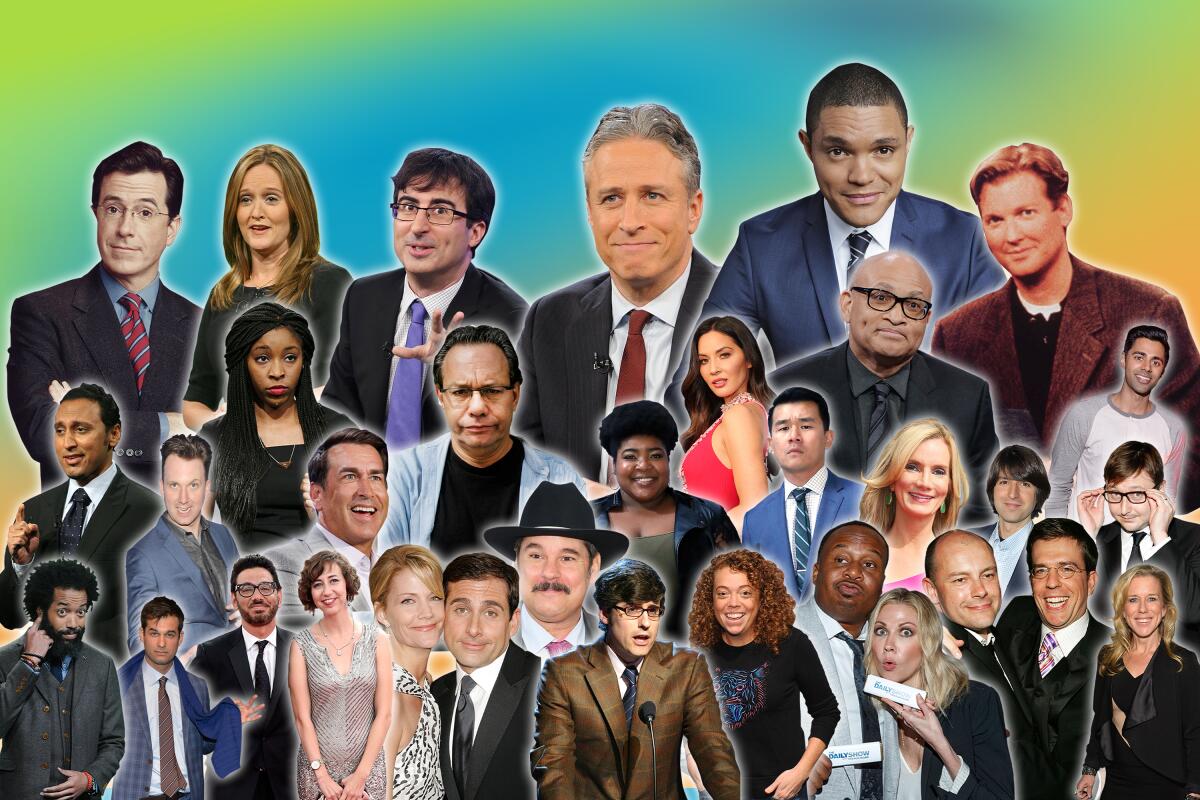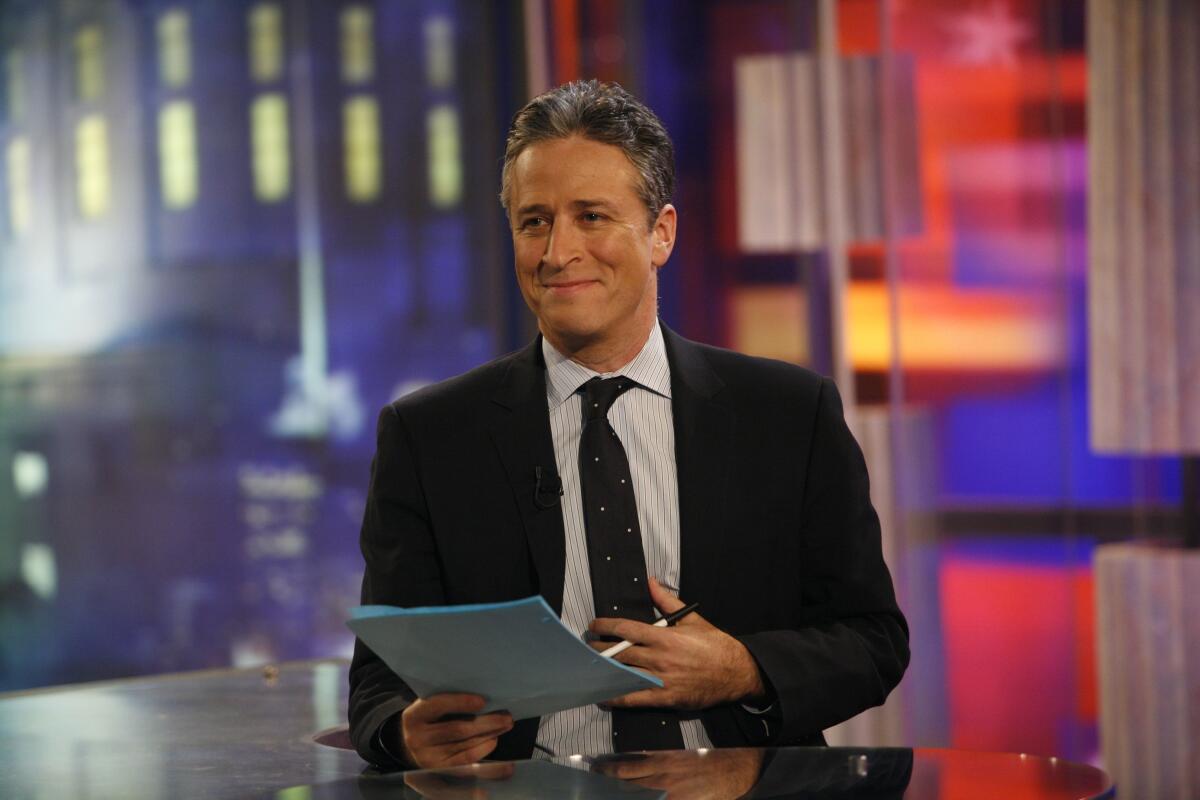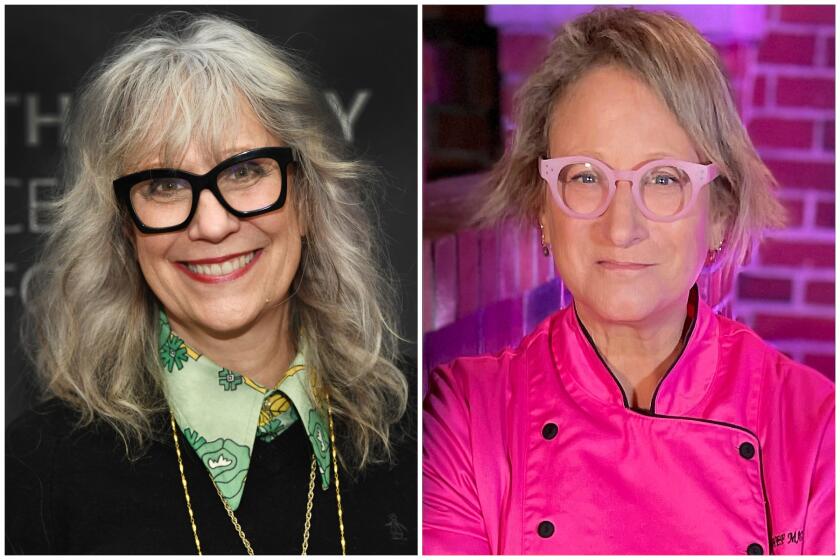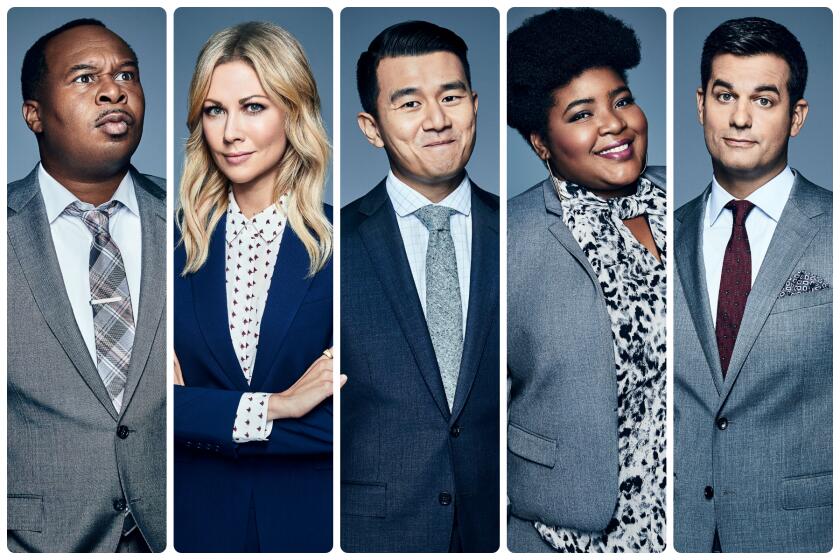What made ‘The Daily Show’ the most influential late-night comedy of the last 25 years

When “The Daily Show” premiered on July 22, 1996, on an up-and-coming cable network called Comedy Central, few could have predicted that its blend of satire and current affairs would emerge as one of the most influential — and some might say detrimental — forms of humor on American television.
But it did. Twenty-five years later, The Times looks back on the series’ legacy, including its creation by Lizz Winstead and Madeleine Smithberg; its halcyon years under the leadership of Jon Stewart; its history of news-making political guests; and its current iteration hosted by Trevor Noah and marked by the most diverse cadre of correspondents in its history. Here, Times television critics Lorraine Ali and Robert Lloyd reflect on what “The Daily Show” has meant for comedy, culture and politics, and how the series achieved its unmatched reach.
Lizz Winstead and Madeleine Smithberg created the beloved news satire, which premiered 25 years ago. Why haven’t they gotten credit for it?
Robert Lloyd: It’s been 25 years since the “The Daily Show” premiered, a quarter-century ago — a mathematical redundancy that somehow feels appropriate, expressing its year-by-year slog on the one hand and the huge hunk of history that it represents on the other. It has only had three hosts in that time, with the third surely not going anywhere soon. (If Trevor Noah stays in the job as long as Jon Stewart did, he will be announcing his retirement in 2031, around the time Echo Park becomes beachfront property.)
By contrast, the United States is on its fifth president, and uncountable nervous breakdown, since Craig Kilborn came on the air with a show I’m going to guess few people remember well. It was a different world. In 1996, Netflix did not exist. Amazon was 2 years old and still strictly in the business of destroying independent bookstores. No one was talking about a New Golden Age of Television. “Macarena” was the No. 1 song and grunge was just about completely dead. Simone Biles was not yet born; Trevor Noah was 12 years old and living in Soweto. Still to come: impeachment, hanging chads, 9/11, endless war, the complete breakdown of reality, and the COVID-19 pandemic, not to mention the first Black president and the first Black/Asian/female vice president. (Also: “Veep.”) Facebook was not a thing. Twitter was not a thing. Instagram was not a thing. Climate change was already happening, though.

Lorraine Ali: True. “The Daily Show” did not melt the polar ice caps, but it did contribute to a major shift in the entertainment ecosystem, largely by mainstreaming sharp political satire and breathing new life into late-night television. There would be no “The Late Show With Stephen Colbert” if he hadn’t parodied conservative blowhard Bill O’Reilly on Comedy Central, first on “The Daily Show” and then on “The Colbert Report.” The network’s nightly flagship also launched the careers of John Oliver, Samantha Bee, Hasan Minhaj and Steve Carell, all of whom started as correspondents on the show. Collectively they’ve fanned out across television, along with alumni like Larry Wilmore, Olivia Munn and Michael Che.
But most importantly, “The Daily Show” made the increasingly toxic news churn feel a little less soul-crushing. I barely remember Craig Kilborn, but Jon Stewart got us through some really tough times — 9/11, the war in Iraq, Sarah Palin, the rise of conspiracy-theory politics. And as social media ramped up, so did the firehose of news, real or fabricated. “I have complete faith in the continued absurdity of whatever’s going on,” Stewart once said of the onslaught. When Trevor Noah took over in 2015, he had his work cut out for him. The Lock-Her-Up election. Trump. Russia. The pandemic. White supremacists storming the Capitol. Caitlyn Jenner running for office. Yet he’s managed to make the tortuous hell ride a little less terrifying — and, yes, even fun. “The Daily Show” has had its ups (Aasif Mandvi as a Middle East Correspondent) and downs (too few women), but it’s incredible when you consider the influence it’s had on popular culture.
The complete guide to home viewing
Get Screen Gab for everything about the TV shows and streaming movies everyone’s talking about.
You may occasionally receive promotional content from the Los Angeles Times.
Lloyd: Especially given that it’s a show on Comedy Central — basic cable! — though undoubtedly it was the fact that it developed in relative obscurity that allowed the program to find its voice, build a following and a reputation and become part of the national political discourse. That Stewart always claimed he was an entertainer and not a journalist — accurate, after all, given the show’s mix of fact with satirical fancy — did not stop viewers from making it part of their news diet. Irony is a great revealer of truth; Colbert made a career out of it on “The Colbert Report.” The difference between “The Daily Show” and a highly disingenuous program like Tucker Carlson’s is that “Daily Show” viewers can tell a dessert from the entree.
I can’t swear that Stewart or his writers coined the term “fake news,” but it’s the first place I remember hearing those words put together, as part of “fake news show,” not a show full of “fake news” but a “news show” that was fake. Now it’s become a finger pointed at anything reported that doesn’t jibe with Trump-ian unreality.
Ali: Oh, the irony (“Daily Show” fans get it). Another aspect of the show that differentiates it from a sketch-comedy forerunner like “Saturday Night Live’s” “Weekend Update” segment is that there’s a sense of activism, or at least of righting some wrongs, in between the jokes and the guest interviews. Stewart was relentless in questioning the intelligence and motives that got us into the Iraq war, a conflict he referred to as “Mess O’Potamia.” He supported and hired veterans of that and the Afghanistan wars. He spent many a night shining a light on the subprime mortgage nightmare that contributed to the 2008 economic collapse. And Iran, wow. Just look up “Rosewater.”
Noah, who is South African, has continually taken on bigoted politicians and policies around immigration, race and policing. He mopped the floor with race-baiter Tomi Lahren in 2016 and delivered one of the most powerful monologues about the murder of George Floyd and the protests that followed that I can recall from the worst year ever — then he turned around and helped us laugh through a pandemic and a stressful election campaign. Masterful. On the downside, “The Daily Show” was an early marker in the splintering of American media, when the landscape began to polarize around political beliefs, and Stewart was skilled at mining those divides.

Lloyd: Stewart had his own problems with the media, to be sure, mainstream as much as fringe, to the degree they sacrificed debate and reporting for ratings and noise. There was his famous 2004 appearance on CNN’s “Crossfire” where he accused co-hosts Carlson and Paul Begala of sacrificing actual debate for “partisan hackery,” an appearance that has recirculated on social media over the years, as recently as this March. Both the show, which employed different hosts over the years, and Carlson’s contract, were canceled not long after, by some accounts as a direct result of the flaying.
Stewart might have been a comedian, heading a show written by and featuring comedians, but his passion was real enough. I wonder how he would have survived the job in the Trump years? Trevor Noah’s coolness — not that anyone was actually expecting a President Trump when Noah was hired — might have been the necessary attitude.
Ali: But five years of covering Trumpism is equal to 25 years in the Before Times, so Noah has served longer than Stewart and Kilborn combined, and the show has really been going for half a century. Damn, Trevor looks good for his age!
Now, what are your predictions for the next 25 years?
‘Daily Show’ correspondents Ronny Chieng, Michael Kosta, Desi Lydic, Dulcé Sloan and Roy Wood Jr. take us behind the scenes of the ‘comedy PhD program.’
Lloyd: Besides that Noah will continue to age handsomely? (It’s a rare safe bet in an imploding world.) Obviously, given the insane political climate with its conspiracy theorists and truth denialists, 8 million books from inside the Trump White House, and various suits, prosecutions and investigations, there will be, sadly, no lack of material. I’ll be interested to see what happens when the show returns from hiatus in September — are they planning to get back in a studio with a studio audience? I’ve liked the “Social Distancing” conceit; I think Noah’s been great in the job almost since the beginning, but pandemic rules have been good for the show. He’s literally let his hair, not down, but out. Taking away the spaceship news desk set and putting him in a corner of his apartment sacrificed the “comedian newsman” element he inherited from Stewart, but without an audience to play to the rhythms feels more original, the presentation more personal, the intent (funny voices notwithstanding) more serious. Just Trevor and his Zoomed-in guests. Something of the same has benefited Seth Meyers on “Late Night,” which is in many ways a stepchild of “The Daily Show” and is closer to what its alums like Bee and Oliver and, in large part, Colbert are doing than to the work of other network late-night hosts — Fallon, Kimmel, Corden. But, really, it’s all past predicting. All I know is that, here in the world, things are going to get worse before they get better, if they get better, and we’re going to need “The Daily Show” for some time to come.
Ali: If only I could promise you a future of rainbows and unicorns instead of voter suppression and neo-Nazis. Either way, “The Daily Show” and its disciples will surely be there to cover, expose and lampoon whatever comes next. Collectively they’ve made political satire mainstream, and Americans more aware of the myriad ways they’re being swindled, cheated and hoodwinked. Here’s to the next quarter-century — and beyond.
More to Read
The complete guide to home viewing
Get Screen Gab for everything about the TV shows and streaming movies everyone’s talking about.
You may occasionally receive promotional content from the Los Angeles Times.










